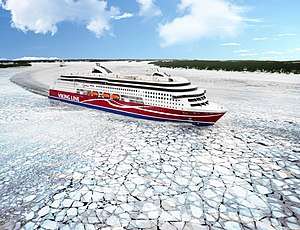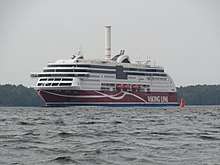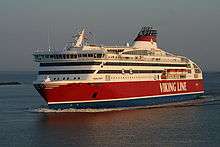MS Viking Grace
MS Viking Grace is a cruiseferry constructed at STX Europe Turku Shipyard, Finland for the Finland-based ferry company Viking Line. The ship was delivered to her owners on 10 January 2013, and entered service on 13 January 2013. It is the first large scale passenger ferry to be powered by liquefied natural gas (LNG)[6] as well as being fitted with a rotor sail.
 | |
| History | |
|---|---|
| Name: | Viking Grace |
| Owner: | Viking Line |
| Port of registry: |
Mariehamn, |
| Route: | Turku–Mariehamn–Stockholm |
| Ordered: | 22 December 2010[2] |
| Builder: | STX Europe Turku Shipyard, Finland |
| Cost: | 240 million euro (estimate)[2] |
| Yard number: | 1376[3] |
| Laid down: | 6 March 2012 |
| Launched: | 10 August 2012[1] |
| Completed: | 10 January 2013 [1] |
| Maiden voyage: | 13 January 2013[1] |
| In service: | 2013–Present |
| Identification: | IMO number: 9606900Call sign: OJPQ MMSI number: 230629000 |
| Status: | In service |
| General characteristics | |
| Type: | Cruiseferry |
| Tonnage: | 57,565 GT[4] |
| Length: | 218 m (715 ft 3 in) |
| Beam: | 31.8 m (104 ft 4 in) |
| Ice class: | 1A Super[2] |
| Installed power: | 4 × Wärtsilä 8L50DF (4 × 7,600 kW)[5] |
| Propulsion: | Diesel-electricTwo shafts, fixed pitch propellers |
| Speed: | 22 knots (41 km/h; 25 mph)[1] |
| Capacity: | 2,800 passengers[2]1,275 lane meters for ro-ro cargo1,000 lane meters for cars[1] |
| Crew: | 200[2] |
Construction
Construction on the ship started on 28 November 2011. The ship's name was announced as Viking Grace on 17 February 2012.
Principal Particulars
Viking Grace has a length of 218 m (715 ft 3 in), beam of 31.8 m (104 ft 4 in) and maximum summer draft of 6.80 m (22 ft 4 in). The ship has a deadweight tonnage of 6,107 DWT and a gross tonnage of 57,565 GT, which gives maximum passenger capacity for 2,800 people. The vessel has 880 rooms, restaurants, bars, spa and shopping centers. Also on board of MS Viking Grace there are 1,000 m for cars and 1,275 m for storage of Ro-Ro cargo.
Engineering

Viking Grace is driven by four diesel/gas electric engines Wärtsilä 8L50DF, each with power of 10,100 HP and was the first LNG powered passenger ship. The ferry is also the first modern passenger ship that has been fitted with a rotor sail,[7] which allows for hybrid usage of LNG and wind power.[8] The new technology is called Rotor Sail Solution and was developed by the Finnish company Norsepower. It has produced a fuel saving of up to 20% in favourable wind conditions.[9]
The rotor cylinder has a height of 24.00 m and a width of 4.00 m. During operation, the cylinder rotates and receives power from the airflow. Such propulsion was developed and patented by the German engineer Anton Flettner in 1922.
References
- M/S Viking Gracen vesillelasku. Viking Line, 10 August 2012. Retrieved 2012-08-10.
- "Viking Line NB 1376" (PDF). Archived from the original (PDF) on 2016-09-08. Retrieved 2012-01-23.
- "NB 1376.com". Archived from the original on 2012-01-18. Retrieved 2012-01-23.
- "Marine Traffic Viking Grace". Retrieved 2016-10-05.
- Viking Grace. Wärtsilä. Retrieved 2012-07-13.
- http://www.iltalehti.fi/uutiset/2013011316550074_uu.shtml
- Peter Kleinort: Erstmals Flettner-Rotor für Passagierfähre · „Viking Grace“ fährt schon mit LNG-Antrieb · Sparpotenzial liegt bei 900 Tonnen CO2 und 300 Tonnen LNG jährlich. In: Täglicher Hafenbericht vom 8. Februar 2017, S. 1+4
- "Cruise ferry Viking Grace install turbosail for hybrid usage of wind power". January 27, 2017.
- "Norsepower". Norsepower. Retrieved 2018-05-03.
External links

- Viking Grace Video Clips
- Viking Grace by ShipsReviews.com
